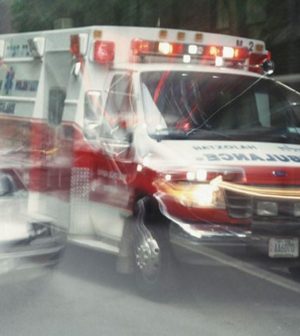- How Savvy Habits May Help Head Off Dementia
- HHS Launches New Autism Study Despite Experts’ Concerns
- CDC Urges Extra Measles Shot For Some U.S. Travelers Amid Outbreak
- Showerhead Water Limits Rescinded as Trump Targets Household Appliances
- Most Women Aren’t Clear When Menopause Might Start
- New Visual Test For Autism Could Aid Earlier Diagnosis
- Half-Million Children Could Die If U.S. AIDS Relief Is Dropped
- Seasonal Allergies Likely To Grow Worse Under Climate Change
- First Baby Born From Robot-Controlled IVF
- Eviction Bans Linked To Drop In Child Abuse Reports
High Deductibles Keep Folks With Chest Pain From Calling 911

The public health message has always been loud and clear: If you are experiencing a medical emergency such as chest pain, dial 911 or go to the nearest emergency room.
But a new study shows that a $1,000 or higher deductible on your health insurance plan may serve as a deterrent to seeking care when you experience chest pain that could signal a heart attack.
“Plans with high out-of-pocket costs, such as high-deductible health plans, put patients with chest pain in a difficult spot of balancing their financial well-being against the potential risk of significant heart disease,” said study author Dr. Shih-Chuan Chou.
“If someone experiences chest pain, the best course of action remains to seek medical attention in a timely fashion,” added Chou, an emergency care physician at Brigham and Women’s Hospital in Boston.
For this study, the researchers reviewed claims from a nationwide U.S. health insurer from 2003 to 2014. They identified people whose employers offered only low-deductible health plans with ($500 or less a year) during the first year and then mandated enrollment in a high-deductible health plan ($1,000 or more a year) the second year. There were more than 500,000 employees in the high-deductible group and nearly 6 million people in a low-deductible health plan for two years in a row.
Folks who switched to a high-deductible health plan had a 4% drop in emergency room visits for chest pain and an 11% decrease in ER visits for chest pain that required hospitalization, the study showed.
High deductibles seem to be even greater deterrents among people with low incomes. People from poorer neighborhoods were nearly one-third more likely to have a heart attack during a subsequent hospitalization 30 days after their initial emergency room visit for chest pain.
The study appears in the June 28 issue of Circulation.
It’s not always easy to tell if your chest pain is a heart attack or something less serious, Chou said. As many as 7 million people go to the emergency room for chest pain each year, but more than 80% of them are not actually having a heart attack.
“Chest pain … can be caused by something benign such as reflux or something severe like a heart attack,” Chou said. Without immediate and often costly testing, you can’t tell if your chest pain is a heart attack or not.
“Delayed or missed heart attack treatments can lead to a cascade of heart problems,” he added.
Everyone’s risk of heart attack is different based on factors that include age, sex, cigarette use, chronic medical problems and many others, said Dr. Felipe Serrano, an emergency medicine physician at Mount Sinai Morningside in New York City.
“If you are older and have risk factors for heart disease or a family history that is concerning, come to the emergency room regardless of your deductible or insurance status. Your health is much more important than your deductible,” said Serrano, who wasn’t part of the study.
It’s always better to be safe than sorry. “We see a lot of indigestion and anxiety, but we do see the occasional unexpected heart attack in a young person with no other risk factors,” Serrano said.
But “if you do come to the emergency room for chest pain, you will undergo a battery of tests to rule out a heart attack even if it is likely that your symptoms are caused by indigestion, and this can result in exorbitant bills or hospitalization,” he added.
If you have a primary care doctor, you should always go that route first, Serrano said. Of course, not all primary care doctors are available when an emergency happens. Urgent care centers may be able to rule out heart attacks in a less costly manner, he said.
Two Stanford University cardiologists, Dr. Neil Kalwani and Dr. Alexander Sandhu, wrote an editorial accompanying the new study. “These health plans put patients at financial risk when deciding whether an emergency department visit is needed,” Kalwani said.
“There are policies that can help to mitigate these effects: lower deductibles for low-income patients, having employers contribute more money to health savings accounts for low-income employees, and expanding value-based insurance design, in which patients do not have to pay as much out of pocket for high-value services,” Kalwani noted.
More information
The American Heart Association offers more about the warning signs of a heart attack.
SOURCES: Shih-Chuan Chou, MD, MPH, emergency care physician, department of emergency medicine, Brigham and Women’s Hospital, Boston; Neil Kalwani, MD, chief cardiology fellow, Stanford University, Palo Alto, Calif; Felipe Serrano, MD, emergency medicine physician, Mount Sinai Morningside, New York City; Circulation, June 28, 2021
Source: HealthDay
Copyright © 2025 HealthDay. All rights reserved.










